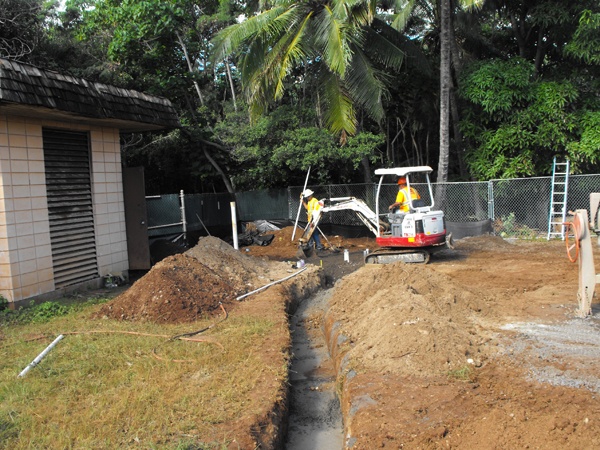WAILUA — The smell of rotten eggs, county officials admit, has been a longstanding and uncomfortable problem that has plagued businesses and residents in the Wailua Houselots area for several decades. “Although we’ve had some breezy winds, when it’s still
WAILUA — The smell of rotten eggs, county officials admit, has been a longstanding and uncomfortable problem that has plagued businesses and residents in the Wailua Houselots area for several decades.
“Although we’ve had some breezy winds, when it’s still like this it kind of lingers around there,” Council Chair Jay Furfaro said about the smell, which eminates from the manholes near the county’s Coco Palms Sewage Pump Station at the intersection of Kuhio Highway and Haleilio Road.
Some relief, however, may be in sight as county contractors ramp up work on a long-awaited project to mollify the putrid smell, if not eliminate it.
“I think people pretty much know the situation there — a longstanding odor problem — and I’m happy to say that I think we’re making significant progress on resolving it,” Wastewater Division Manager Edward Tschupp said during the County Council’s Feb. 5 public meeting, where the latest project update was delivered.
The most significant progress, he said, happened last month, when county contractors removed the fences around the tranfer station and began laying down the foundation needed for the county’s OHxyPhogg system, a proprietary system designed to target the source of the smell: hydrogen sulfide.
A notice to proceed with the first phase of the project, totaling $135,670, was submitted to Kalaheo-based Cushnie Construction Company, Inc. in January.
The equipment, Tschupp said, has also been delivered, and as of the end of January, construction is about 35 percent complete for contracted site work.
Known for its characteristic smell of rotten eggs, hydrogen sulfide is a colorless, flammable gas that can be poisonous under certain conditions.
“Because it is heavier than air, hydrogen sulfide can collect in low-lying and enclosed spaces, such as manholes, sewers, and underground telephone vaults,” according to the Occupational Safety and Health Administration (OSHA). “Its presence makes work in confined spaces potentially very dangerous.”
The county’s OHxyPhogg system, Tschupp said, mixes water and air in a patented nozzle to create an oxygenated type of fog inside a manhole or sewage pump station wet well.
The fog then oxidizes hydrogen sulfide vapor in the air inside the manhole or wet well, washing it down to the sewage below, which is then carried along to a wastewater treatment plant.
“I know the system works, so for all my friends and family in Wailua Houselots, relief is on its way,” Councilman Tim Bynum said. “I believe it works and I appreciate the due diligence.”
The odor issue, Tschupp said, began in the 1970s when the sewage system was extended to local area resorts and became more prevalent by the 1990s when the sewer system was expanded to Kapaa.
Funding for the project, however, was not secured until 2011, allowing the procurement and design process to begin the next year.
Although the air that exits the wet wells through manholes are rapidly diluted and are far below OSHA’s hydrogen sulfide exposure standards, Tschupp said the human nose is sensitive to the chemical compound and can detect its characteristic “rotten egg” smell at very low levels.
“The wet well is not completely sealed so that no air and go in or out — that would create problems and would start acting like there is a block in the sewer line, and cause sewage to back up elsewhere,” Tschupp wrote in an email. “So a small amount of air moves into and out of the wet well during the normal operation of the facility.
During an equipment test done in 2012, hydrogen sulfide levels inside wet wells of the sewage pump station reached as high as 300 milligrams per liter or part per million.
“The wet well is an enclosed space not intended for human entry,” Tschupp explained in an email. “Were a person to enter this space, they would need a respirator and probably an air tank. We do not go in there.”
Tests done after the OHxyPhogg spray, however, resulted in hydrogen sulfide levels that, in some cases, were barely detectable.
“I anticipate there will be some fine tuning next month when the system is lit up and made to go live,” Tschupp said. “We expect that we’ll see the same kind of reduction in the wet well and that translates also to the atmosphere.”
The contractor, he said, is scheduled to begin testing the OHxyPhogg system during the week of March 17.
The projected completion date is tentatively scheduled for the end of March.
“This is so refreshing to hear about progress on a longstanding problem,” Councilwoman JoAnn Yukimura said to Tschupp and County Engineer Larry Dill. “I know that you are not at the end yet, but we’ll get there.”
• Darin Moriki, county government reporter, can be reached at 245-0428 or dmoriki@thegardenisland.com. Follow him on Twitter at @darinmoriki.


